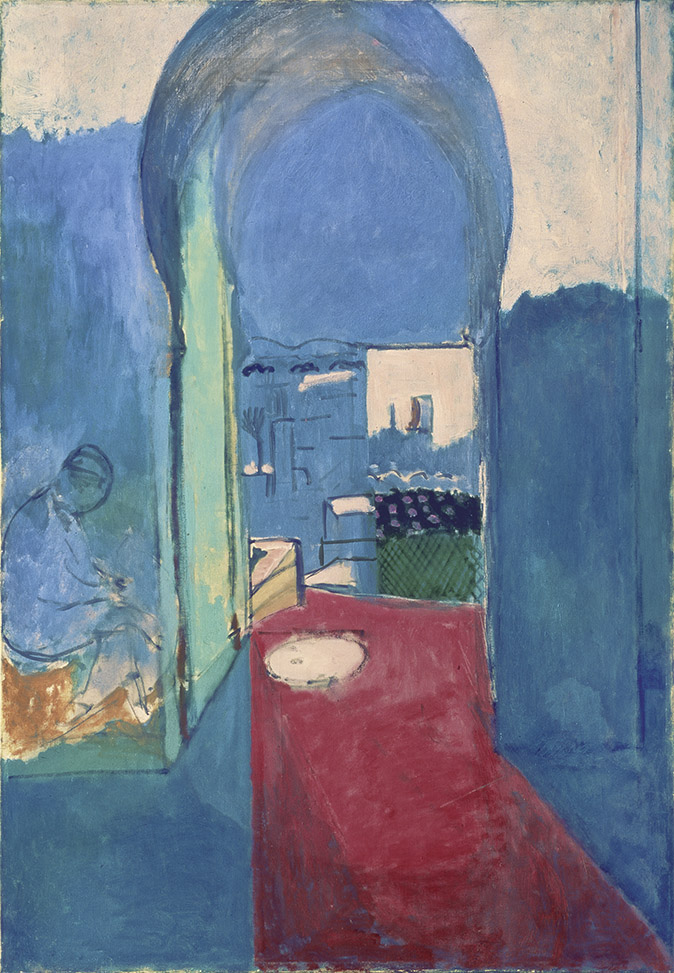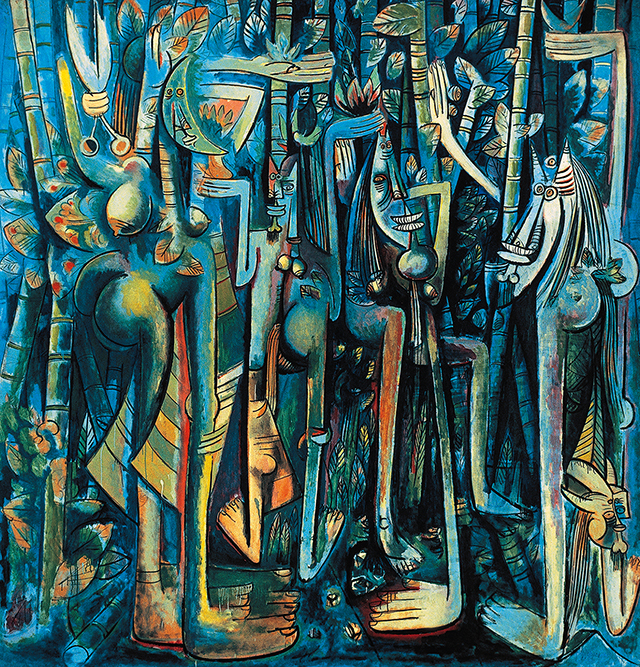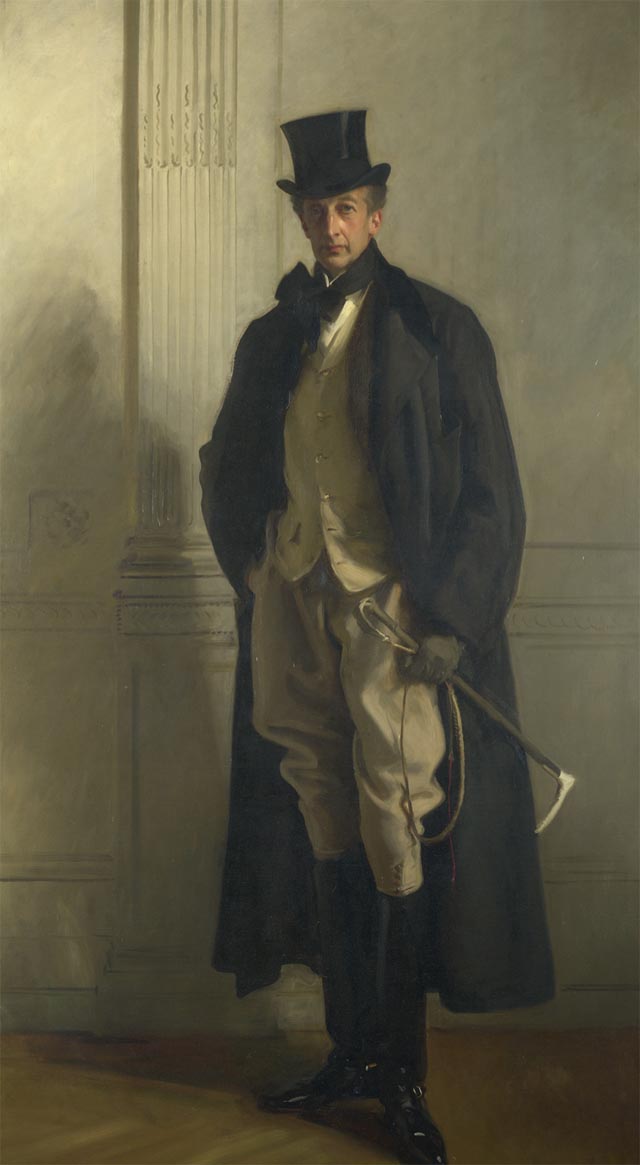My favourite painting: Lachlan Goudie
'It’s a series of prompts, unlocking the viewer’s imagination'


The Casbah Gate, 1912–13, by Henri Matisse (1869–1954), 45½in by 31½in, Pushkin State Museum of Fine Arts, Moscow
Lachlan Goudie says: The Casbah Gate is a masterclass in simplification. Matisse distills the essence of his subject into an abstract pattern of geometric shapes and colour, yet this image completely evokes the allure of a street in the Casbah, blasted by the noonday sun. It’s a series of prompts, unlocking the viewer’s imagination; electric turquoise and blood crimson, clamouring together for your attention like the noise of street vendors in the souk. And there, materialising at the heart of all the visual clamour, is the promise of a rose garden, leading the viewer through the arch, along a burning-red path and into Matisse’s painted world.
Lachlan Goudie is an artist and broadcaster. He features in the new film Painting the Modern Garden: Monet to Matisse, which will be released in the UK on April 12
John McEwen comments on The Casbah Gate: In old age, Matisse wrote of making art: ‘You have to see the whole of life as you did when a child; and the loss of that potentiality robs you of the personality to express yourself in an original way— that is to say, personally.’
Matisse had not found it easy to be an artist, neither as a young man abandoning a law career against his father’s wishes nor when he was at odds with Cubism and the younger Picasso and his Cubist coterie refused him a cafe seat—a stinging snub. In 1908, he met the inspiring Russian patron Sergei Shchukin. Staying with him in Moscow, he was astonished by the visual riches of icons.
Then, typically of French painters since Delacroix (see ‘Delacroix and the Rise of Modern Art, national Gallery’, until May 22), he visited Morocco, staying in Tangier. He and his wife survived a dismal start, but, after weeks of rain, sun provided a ‘melting light, quite different from the Cote d’Azur’ and bare earth was suddenly carpeted with flowers. He paid two extended visits. During the second, he painted this personal view of an old gateway to the Casbah, the original citadel.
Matisse avoided the numerous foreign artists in Tangier, but he did meet the Glasgow School painter Lavery. They disliked each other’s art. Matisse’s would not ‘wash in the long run’, the Scottish painter Guthrie reassured Lavery. A century later, Lachlan Goudie, whose TV series on Scottish art was distinguished by a practitioner’s insight, confirms Guthrie’s misjudgement. Lavery’s art has washed quite well, too, of course.
Sign up for the Country Life Newsletter
Exquisite houses, the beauty of Nature, and how to get the most from your life, straight to your inbox.

My favourite painting: Carlos Acosta
Carlos Acosta chooses his favourite painting for Country Life

My favourite painting: David Starkey
David Starkey shares the one painting he would own, if he could
Country Life is unlike any other magazine: the only glossy weekly on the newsstand and the only magazine that has been guest-edited by HRH The King not once, but twice. It is a celebration of modern rural life and all its diverse joys and pleasures — that was first published in Queen Victoria's Diamond Jubilee year. Our eclectic mixture of witty and informative content — from the most up-to-date property news and commentary and a coveted glimpse inside some of the UK's best houses and gardens, to gardening, the arts and interior design, written by experts in their field — still cannot be found in print or online, anywhere else.
-
 The King's favourite tea, conclave and spring flowers: Country Life Quiz of the Day, April 22, 2025
The King's favourite tea, conclave and spring flowers: Country Life Quiz of the Day, April 22, 2025Tuesday's Quiz of the Day blows smoke, tells the time and more.
By Toby Keel
-
 London is the place for me* (*the discerning property buyer)
London is the place for me* (*the discerning property buyer)With more buyers looking at London than anywhere else, is the 'race for space' finally over?
By Annabel Dixon
-
 'As a child I wanted to snuggle up with the dogs and be part of it': Alexia Robinson chooses her favourite painting
'As a child I wanted to snuggle up with the dogs and be part of it': Alexia Robinson chooses her favourite paintingAlexia Robinson, founder of Love British Food, chooses an Edwin Landseer classic.
By Charlotte Mullins
-
 The Pre-Raphaelite painter who swapped 'willowy, nubile women' for stained glass — and created some of the best examples in Britain
The Pre-Raphaelite painter who swapped 'willowy, nubile women' for stained glass — and created some of the best examples in BritainThe painter Edward Burne-Jones turned from paint to glass for much of his career. James Hughes, director of the Victorian Society, chooses a glass masterpiece by Burne-Jones as his favourite 'painting'.
By Charlotte Mullins
-
 'I can’t look away. I’m captivated': The painter who takes years over each portrait, with the only guarantee being that it won't look like the subject
'I can’t look away. I’m captivated': The painter who takes years over each portrait, with the only guarantee being that it won't look like the subjectFor Country Life's My Favourite Painting slot, the writer Emily Howes chooses a work by a daring and challenging artist: Frank Auerbach.
By Toby Keel
-
 My Favourite Painting: Rob Houchen
My Favourite Painting: Rob HouchenThe actor Rob Houchen chooses a bold and challenging Egon Schiele work.
By Charlotte Mullins
-
 My Favourite Painting: Jeremy Clarkson
My Favourite Painting: Jeremy Clarkson'That's why this is my favourite painting. Because it invites you to imagine'
By Charlotte Mullins
-
 The chair of the National Gallery names his favourite from among the 2,300 masterpieces — and it will come as a bit of a shock
The chair of the National Gallery names his favourite from among the 2,300 masterpieces — and it will come as a bit of a shockAs the National Gallery turns 200, the chair of its board of trustees, John Booth, chooses his favourite painting.
By Toby Keel
-
 'A wonderful reminder of what the countryside could and should be': The 200-year-old watercolour of a world fast disappearing
'A wonderful reminder of what the countryside could and should be': The 200-year-old watercolour of a world fast disappearingChristopher Price of the Rare Breed Survival Trust on the bucolic beauty of The Magic Apple Tree by Samuel Palmer, which he nominates as his favourite painting.
By Charlotte Mullins
-
 My favourite painting: Andrew Graham-Dixon
My favourite painting: Andrew Graham-Dixon'Lesson Number One: it’s the pictures that baffle and tantalise you that stay in the mind forever .'
By Country Life